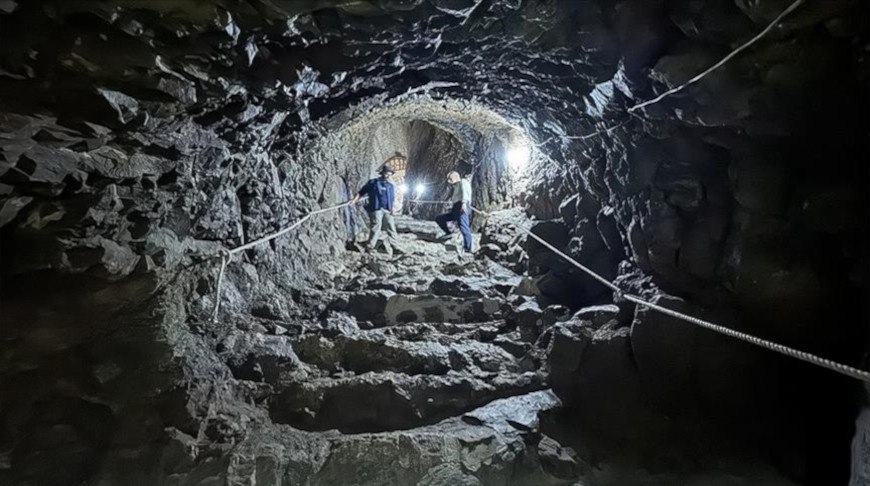
ELAZIG, 22 August (BelTA - Anadolu) - The restoration of a nearly
2,800-year-old water cistern from the Urartu period that was discovered
in Harput Castle in the eastern Anatolia region of Türkiye has been
completed.
Located in Elazig province, Harput Castle, which has hosted numerous civilizations over the centuries, continues to be the focus of archaeological excavation and restoration efforts that began in 2004.
The castle, where the traces of the first settlements date back to 3000 B.C. and was later fortified by the Urartu Kingdom, is revealing artifacts and structures.
In the historic Harput neighborhood, which is on the UNESCO World Heritage Tentative List, the restoration of the second water cistern with 52 steps, located in the castle, has been completed after the restoration of the first Urartu-period cistern with 112 steps, which was opened to tourism in 2021.
The second cistern measures nearly 4.5 meters (14.7 feet) in diameter and 30 meters (98.4 feet) deep and is notable for its structure carved into the rocks.
The restoration of the second cistern is complete, and it will be opened to visitors once the access road is arranged, Ismail Aytac, who leads the Harput Castle excavation, told Anadolu.
Aiming for visitors to gain insight into region's history
Aytac said the large water cisterns carved into the rocks and accessed by steps in Harput Castle are significant structures in terms of history and tourism.
He said the restoration of the 112-step cistern from the Urartu period was completed in 2021 and opened to tourism.
He also noted that Harput Castle contains many smaller cisterns but only two large stepped cisterns, adding the first, known as the dungeon where a Crusader king was imprisoned during the Seljuk period, was opened to tourism in previous years.
"The restoration of the second stepped water cistern has recently been completed," Aytac said. “It is a 4-meter diameter cistern carved into natural rock, descending 30 meters down with 52 steps.”
The cisterns are about 2,800 years old and were used for water supply by subsequent civilizations, he added.
"The significance of this site (cistern) is that it is one of the most important and largest cisterns carved into natural rock in Türkiye. When the water ran out, it was used for food storage.”
Underlining that their aim is to open the cistern to visitors, Aytac said “we want visitors to gain insight into the region's history.”
Located in Elazig province, Harput Castle, which has hosted numerous civilizations over the centuries, continues to be the focus of archaeological excavation and restoration efforts that began in 2004.
The castle, where the traces of the first settlements date back to 3000 B.C. and was later fortified by the Urartu Kingdom, is revealing artifacts and structures.
In the historic Harput neighborhood, which is on the UNESCO World Heritage Tentative List, the restoration of the second water cistern with 52 steps, located in the castle, has been completed after the restoration of the first Urartu-period cistern with 112 steps, which was opened to tourism in 2021.
The second cistern measures nearly 4.5 meters (14.7 feet) in diameter and 30 meters (98.4 feet) deep and is notable for its structure carved into the rocks.
The restoration of the second cistern is complete, and it will be opened to visitors once the access road is arranged, Ismail Aytac, who leads the Harput Castle excavation, told Anadolu.
Aiming for visitors to gain insight into region's history
Aytac said the large water cisterns carved into the rocks and accessed by steps in Harput Castle are significant structures in terms of history and tourism.
He said the restoration of the 112-step cistern from the Urartu period was completed in 2021 and opened to tourism.
He also noted that Harput Castle contains many smaller cisterns but only two large stepped cisterns, adding the first, known as the dungeon where a Crusader king was imprisoned during the Seljuk period, was opened to tourism in previous years.
"The restoration of the second stepped water cistern has recently been completed," Aytac said. “It is a 4-meter diameter cistern carved into natural rock, descending 30 meters down with 52 steps.”
The cisterns are about 2,800 years old and were used for water supply by subsequent civilizations, he added.
"The significance of this site (cistern) is that it is one of the most important and largest cisterns carved into natural rock in Türkiye. When the water ran out, it was used for food storage.”
Underlining that their aim is to open the cistern to visitors, Aytac said “we want visitors to gain insight into the region's history.”













